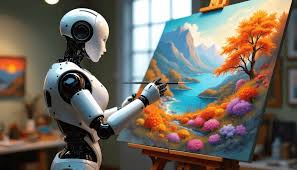AI is transforming art and design pedagogy by expanding creative possibilities, personalizing learning, fostering cross-disciplinary collaboration, and reshaping the role of educators. While it presents challenges that must be addressed, its potential to enrich the educational experience is undeniable.
The Impact of AI on Art and Design Pedagogy
The integration of artificial intelligence into art and design education is reshaping how creativity is taught, learned, and practiced. Traditionally, art and design pedagogy focused on developing manual skills, critical thinking, and conceptual exploration through hands-on studio work. Today, AI technologies are augmenting these approaches, offering new tools, workflows, and possibilities that expand the boundaries of artistic expression. As of 2025, the influence of AI on art and design education has become a defining feature of the modern creative learning environment.
Expanding creative possibilities in the classroom
AI introduces a new dimension to the creative process by automating technical tasks and generating ideas that may not emerge through traditional methods. For example, AI-driven design tools can suggest color palettes, generate layout variations, or create quick prototypes from simple sketches or textual prompts. This allows students to explore a broader range of visual concepts in a shorter amount of time.
By removing some of the manual constraints, AI enables learners to focus more on conceptual development and experimentation. This shift not only accelerates the learning process but also fosters a mindset that blends traditional craftsmanship with digital innovation.
Enhancing personalized learning experiences
One of AI’s strongest contributions to art and design pedagogy is its ability to tailor learning to individual needs. Adaptive learning platforms can analyze a student’s strengths, weaknesses, and creative preferences to provide customized exercises, tutorials, and project suggestions.
For example, a student struggling with perspective drawing might receive AI-generated practice modules, while another excelling in digital painting could be introduced to advanced generative art techniques. This level of personalization allows educators to support diverse learning paces and styles more effectively than a one-size-fits-all approach.
Facilitating cross-disciplinary collaboration
Modern art and design education increasingly values collaboration across fields such as computer science, engineering, and business. AI tools act as a bridge between these disciplines, enabling design students to work with programmers on interactive installations, or collaborate with data scientists to create visualizations from large datasets.
By integrating AI into the curriculum, institutions prepare students to thrive in environments where creative and technical expertise intersect. This collaborative approach mirrors industry trends, where design teams often work alongside AI engineers to bring innovative products to market.
Transforming the role of educators
AI is changing not only how students learn but also how educators teach. Rather than spending significant time on repetitive demonstrations or manual grading, instructors can use AI-powered assessment tools to evaluate technical proficiency and provide instant feedback. This frees them to focus more on mentoring, guiding conceptual development, and fostering critical discourse about art and design.
Moreover, AI tools can help educators stay updated with emerging creative technologies, ensuring that course content reflects the latest industry practices. By embracing AI as a teaching partner rather than a replacement, educators can enrich their role in shaping well-rounded creative professionals.
Encouraging critical thinking about technology’s role in art
While AI opens exciting possibilities, it also raises important questions about originality, authorship, and ethics. Art and design pedagogy must address these issues to prepare students for the realities of working in a technology-driven creative industry.
Educators are incorporating critical discussions about the implications of AI-generated content, intellectual property rights, and the potential biases embedded in algorithms. This encourages students to think critically about the tools they use, ensuring they understand both the benefits and the limitations of AI in creative practice.
Expanding access to creative education
AI-powered tools can lower the barriers to entry for learning art and design by providing affordable and accessible alternatives to traditional studio equipment. For example, AI-assisted software can replicate techniques like oil painting, sculpture modeling, or architectural rendering without the need for costly materials or specialized facilities.
This democratization of creative tools enables more people from diverse backgrounds to engage in art and design education, fostering a more inclusive and globally connected creative community.
Challenges and concerns in AI-integrated pedagogy
Despite its benefits, the integration of AI into art and design education is not without challenges. Over-reliance on AI tools could lead to skill gaps in fundamental techniques, reducing a student’s ability to create without technological assistance. Additionally, access to high-end AI tools may vary across institutions, creating disparities in educational opportunities.
There is also a risk that AI-generated work may homogenize styles if students rely too heavily on algorithmic suggestions rather than developing their unique creative voices. Educators must strike a balance between embracing AI’s potential and ensuring that traditional artistic foundations remain strong.
Future directions for AI in art and design education
Looking ahead, AI will likely become even more integrated into creative learning environments. Advancements in generative models, real-time collaboration platforms, and immersive technologies like augmented and virtual reality will enable students to co-create with AI in entirely new ways.
Institutions may develop specialized courses focused on AI-assisted design, training students not just to use AI tools but to design and program their own creative algorithms. This will produce graduates who are both artists and technologists, capable of shaping the future of creative industries.
